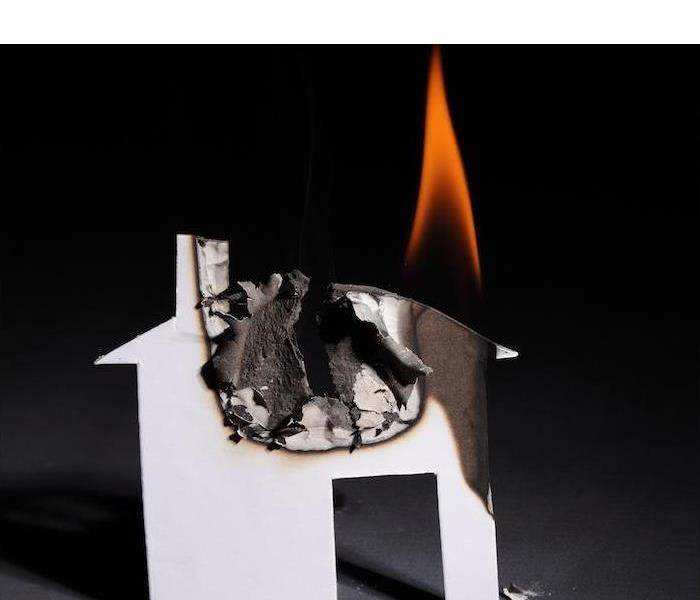The Building Blocks of Every Fire | SERVPRO® of Tallahassee
1/24/2022 (Permalink)
Sometimes all it takes to help a complicated concept make sense is a simple visual aid. That’s the case with fire—though the intricacies of fire can’t be explained in a moment’s time, there’s a visual aid that succinctly explains the origins of every fire.
Fire scientists call it the fire tetrahedron, and its four equal, triangular sides represent the four equal parts that comprise the start and proliferation of every fire, ever.
No, really—every fire boils down to these four elements, and every fire can be combatted by removing any one of them.
Fuel. If you’ve ever eaten food (and it seems pretty likely you have), then you can understand the concept of a fire’s fuel needs. For every fire to begin, there has to be a fuel source for the fire to consume.
Heat. Any potential fuel source has to be flammable, as a matter of course. And any flammable material has to be hot enough to ignite before a fire can occur.
Oxygen. In a similar way, a fire also needs oxygen to survive. The oxygen in the air around a fire feeds the process of oxidation necessary for combustion to begin and repeat.
Chemical Chain Reaction. All these things combine together in a chain reaction which, like objects in Newton’s third law, continues until acted upon by an outside force. What might those forces be? Let’s take a gander.
Cool it. If a fire breaks out in your yard from an errant spark from the fall fire pit, you could wait for winter to cool the air down enough to restore thermal balance between the fire and the fuel…or you could simply dump a bucket of water on it.
Smother it. You know how those little ladybug fireworks are supposed to spin really fast and take off into the sky, but sometimes they only sit there and burn? When you instinctively stamp those things out, you’re actually smothering the fire by cutting off its air supply.
Starve it. The same thing that happens to people who don’t intake calories happens to fires that can’t intake fuel—they weaken, then stop.
Interrupt the chain reaction. These fires are working hard to maintain their reactive cycles, but certain gases have been developed, which, when introduced to the atmosphere around a fire, are able to remove links from the chain reaction and stop the catalytic motion. These are particularly helpful with electrical fires, for which water is unsafe as a coolant.
If the fire tetrahedron makes a wreck of your home or business, we’re ready around the clock to help you recov
Sometimes all it takes to help a complicated concept make sense is a simple visual aid. That’s the case with fire—though the intricacies of fire can’t be explained in a moment’s time, there’s a visual aid that succinctly explains the origins of every fire.
Fire scientists call it the fire tetrahedron, and its four equal, triangular sides represent the four equal parts that comprise the start and proliferation of every fire, ever.
No, really—every fire boils down to these four elements, and every fire can be combatted by removing any one of them.
Fuel. If you’ve ever eaten food (and it seems pretty likely you have), then you can understand the concept of a fire’s fuel needs. For every fire to begin, there has to be a fuel source for the fire to consume.
Heat. Any potential fuel source has to be flammable, as a matter of course. And any flammable material has to be hot enough to ignite before a fire can occur.
Oxygen. In a similar way, a fire also needs oxygen to survive. The oxygen in the air around a fire feeds the process of oxidation necessary for combustion to begin and repeat.
Chemical Chain Reaction. All these things combine together in a chain reaction which, like objects in Newton’s third law, continues until acted upon by an outside force. What might those forces be? Let’s take a gander.
Cool it. If a fire breaks out in your yard from an errant spark from the fall fire pit, you could wait for winter to cool the air down enough to restore thermal balance between the fire and the fuel…or you could simply dump a bucket of water on it.
Smother it. You know how those little ladybug fireworks are supposed to spin really fast and take off into the sky, but sometimes they only sit there and burn? When you instinctively stamp those things out, you’re actually smothering the fire by cutting off its air supply.
Starve it. The same thing that happens to people who don’t intake calories happens to fires that can’t intake fuel—they weaken, then stop.
Interrupt the chain reaction. These fires are working hard to maintain their reactive cycles, but certain gases have been developed, which, when introduced to the atmosphere around a fire, are able to remove links from the chain reaction and stop the catalytic motion. These are particularly helpful with electrical fires, for which water is unsafe as a coolant.
If the fire tetrahedron makes a wreck of your home or business, we’re ready around the clock to help you recover.



 24/7 Emergency Service
24/7 Emergency Service
